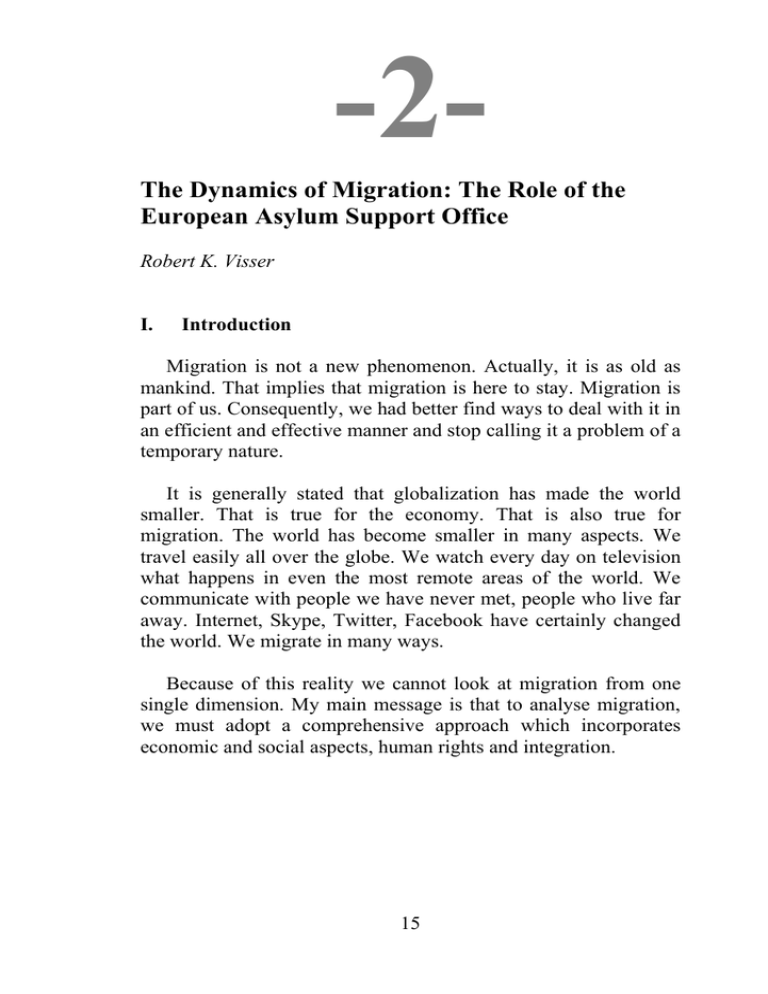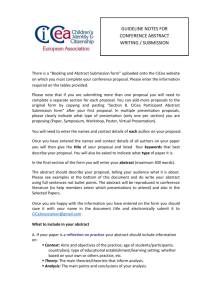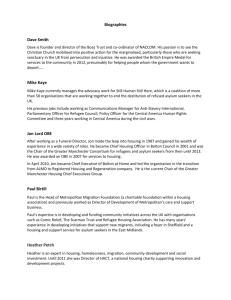-2- The Dynamics of Migration: The Role of the
advertisement

-2The Dynamics of Migration: The Role of the European Asylum Support Office Robert K. Visser I. Introduction Migration is not a new phenomenon. Actually, it is as old as mankind. That implies that migration is here to stay. Migration is part of us. Consequently, we had better find ways to deal with it in an efficient and effective manner and stop calling it a problem of a temporary nature. It is generally stated that globalization has made the world smaller. That is true for the economy. That is also true for migration. The world has become smaller in many aspects. We travel easily all over the globe. We watch every day on television what happens in even the most remote areas of the world. We communicate with people we have never met, people who live far away. Internet, Skype, Twitter, Facebook have certainly changed the world. We migrate in many ways. Because of this reality we cannot look at migration from one single dimension. My main message is that to analyse migration, we must adopt a comprehensive approach which incorporates economic and social aspects, human rights and integration. 15 II. A Comprehensive Approach A comprehensive approach to migration is not only desirable but it is also necessary. For such a holistic approach, we must take into consideration economic aspects, social aspects, human rights and integration. Migration has in many cases an economic or social side. People are looking for a way to improve their life, to seek a new future, to join family or relatives, or just to change their environment and seek adventure. Some of them try to gain access to the territory of the European Union in search for such opportunities. At the same time, there are people who are fleeing and rightfully claiming international protection for themselves and their families. It is an essential part of our shared values that we provide protection to those in need. Although it is sometimes difficult to make a link between the armed conflicts happening in different parts of the world and the number of asylum requests received in the Member States, a large proportion of applications for international protection made in the EU over the past years was linked to security situations in sometimes far away regions of the world. While the events in Syria and in North Africa attracted most public attention over the past two years, new and on-going conflicts, from civil wars to terrorist campaigns, as well as the persecution of minorities by repressive regimes caused a large number of people to leave their country and to look for refuge in the EU. It is our common obligation to provide protection to those in need. At the same time, many applicants from non-conflict regions, or 'those not in direct need of protection' also continued to arrive in the EU over the past years. If there is a lack of channels to gain access to the EU in search for employment, economic migrants might also claim asylum. This creates pressure on Member States’ asylum and reception systems resulting in increased costs both for the EU and for the migrants themselves. 16 III. The EU Asylum Policy It is this context that has brought the EU to develop its asylum policy. This EU asylum policy is being developed at a very fast pace. Until not too long ago, the European Union was mostly focusing on economic issues. Only gradually, justice and home affairs issues gained in importance. The Treaty of Maastricht of 1992 was the first to put the subject of asylum on the EU agenda. In 1999, there was the Tampere Programme, which for the first time established a framework for the EU’s justice and home affairs policy. The terrorist attacks of 11 September 2001 in the United States further highlighted the need of establishing a strong EU justice and home affairs policy. In 2004, the EU adopted the enhanced The Hague Programme, and in 2009, the Stockholm Programme was agreed upon. Since 2004-2005 there has been a set of EU legislation on asylum. Only last year, 2013, this “asylum package” was revised and improved, creating phase two of the Common European Asylum System. In general terms, Europe is currently a border free zone (as far as the Schengen countries are concerned). However, for asylum seekers and beneficiaries of international protection, borders still exist. Their status is only a national decision. One might ask the question if this situation is sustainable in the long term. IV. The Common European Asylum System As said, today the European Union is developing a Common European Asylum System. The Common European Asylum System is a key part of the European Union's objective of progressively establishing an area of freedom, security and justice open to those who seek protection in the Union. In recent years, many decisions have been made on the European level. In particular, after the adoption of the recast Qualification Directive in 2011, the four remaining legal instruments of the ‘Asylum Package’ were officially published on 26 June 2013. The EU Asylum Package provides the legal basis for greater harmonisation 17 and sets higher quality standards. The general understanding is that now we must ‘consolidate’, however as in every ongoing process, further developments shall continue. In order to further develop the Common European Asylum System, Member States must build enough capacity to be able to deal with asylum claims in a fair and efficient manner, offering protection to those who qualify for it, together with measures that ensure their integration into society and a dignified return policy for those who do not qualify for protection and thus have no right to stay in the EU. We need to put the existing legal framework into practice. This is no easy job. The ultimate objective should be to obtain similar outcomes for similar situations through a similar procedure. For example, a Syrian seeking protection should have the same treatment and result if he applies for asylum in Bulgaria, Finland or Portugal. I take the example of a Syrian on purpose since in the EU, we currently have a situation where asylum requests from Syrians get a very similar (positive) outcome in all the Member States. However, the way the request is treated differs from one Member State to another. Therefore, there is still some way to go. The Common European Asylum System has the aim to establish a situation of fair treatment and an area where requests are dealt with in a fair and efficient manner and refusing asylum if the person concerned does not qualify. The asylum process can go both ways. A request for asylum can lead to a positive decision a ‘yes’, or a negative decision, a ‘no’. If it is a ‘yes’ it means that the person concerned must be welcomed as part of our society and we must help that person to integrate. He or she must not feel as a burden on society. A ‘no’ means that he/she is not allowed to stay in the country and that he/she has to leave the country and possibly return. We must not forget the humanitarian side of migration as well as the integration and return aspects. As over 50 % of those who ask for asylum are eventually denied this protection status, it seems there are more economic motivations as their main concern. The sheer size of this group 18 should make us think that we might need to start looking into this issue from a different perspective. The economic aspect also has another dimension to it: that is the importance of access to employment. If we treat asylum seekers as a separate category, it will provide risks to the cohesion within our society. We need to see these people involved in society. For beneficiaries of international protection, access to the labour market would ensure that they become self-sufficient and integrate in society. Integration should be an integral part of the asylum debate. As much as return must be taken into account in the discussion on failed asylum seekers, so integration is also part and parcel of the discussion on successfully supporting beneficiaries of international protection. Granting asylum without taking measures to integrate the beneficiaries is not a solution. Beneficiaries of international protection need to be given the tools to be able to integrate into society (education, language training, employment possibilities, etc...). Positive integration measures would help beneficiaries of international protection to find their place in society and ultimately to contribute to its development. They should feel that they are an asset to society and not a burden. Positive integration could be a win-win situation that enhances social cohesion. There are several examples of best practices of integration in a number of Member States. Integration measures should also be seen in conjunction with any other solidarity measures. V. The Role of the European Asylum Support Office (EASO) Within the broad field of migration the aim of EASO, is to support EU Member States and EU institutions in all the different aspects of the asylum process. EASO’s mission is to contribute to the implementation of the Common European Asylum System by providing support and facilitating, coordinating and strengthening practical cooperation 19 among Member States as an independent centre of expertise on asylum. EASO effectively started on 1 February 2011. In the past three years, we have been able to gather experience and develop a number of tools which EASO uses to support Member States. EASO is now active in all areas of the Common European Asylum System. Our main aim is to support Member States with the implementation of the CEAS. EASO provides: 1. 2. 3. Practical and technical support to Member States; Operational support to Member States with specific needs and to Member States subject to particular pressure on their asylum and reception systems, including the coordination of Asylum Support Teams composed of national asylum experts; Evidence-based input for EU policymaking and legislation in all areas having a direct or indirect impact on asylum To have a situation where similar cases are given similar treatment across the EU, two areas are of prime importance. The first is common training. In this context, EASO provides training and develops training materials in support of the promotion of quality and harmonisation in the area of asylum, as such contributing to the implementation of the Common European Asylum System. Last year alone EASO trained more than 2,100 asylum officials. The cornerstone of EASO training activities is the EASO Training Curriculum, a common vocational training system designed for asylum officials and other target groups such as managers and legal officers throughout the EU. EASO training covers core aspects of the asylum procedure and practice in interactive modules. EASO also develops training for the judiciary and engages in other relevant training initiatives. These include the development of training in cooperation with other EU agencies. In addition to the permanent support activities, EASO delivers ad hoc training 20 sessions in response to the specific needs of Member States under particular pressure. To this end, it has delivered training sessions in Bulgaria, Greece, Italy, Luxembourg and Sweden. The second area is common Country of Origin Information (COI). Country of Origin Information refers to information on countries from which asylum seekers originate. This sort of information is essential for asylum officials during the asylum determination process. Country of Origin Information can play a significant role in the implementation of a Common European Asylum System. In the field of Country of Origin Information, EASO: • Gathers targeted, relevant, reliable, accurate and up-to-date country of origin information in a transparent and impartial manner. • Manages and further develops the EU’s common Country of Origin Information portal, which provides a common entry point to information and offers additional resources for Member States. • Elaborates a common format and methodology for researching and presenting information on countries of origin to foster harmonisation of Country of Origin Information practices. • Drafts reports on key countries of origin reflecting this common format and methodology; in 2012 it published two reports on Afghanistan. • Organises country-specific practical cooperation workshops to share Country of Origin Information, discusses practices and responds to the different information needs of Member States. • In 2013 EASO produced a Comparative Analysis on the push and pull factors related to the Western Balkans. Operational support given by EASO also contributes to the development of the CEAS. EASO offers two kinds of specific support to Member States, namely ‘special support’ and 21 ‘emergency support’. Special support refers to tailor-made assistance, capacity building, facilitation and coordination of relocation, specific support and special quality control tools. Emergency support refers to organising solidarity for Member States subject to particular pressures by providing temporary support and assistance to repair or rebuild asylum and reception systems. EASO has already offered this kind of support (emergency and special) to six Member States and has on-going operations in four Member States, namely Greece, Italy, Bulgaria, and Cyprus. To have a good overview of the situation of asylum EASO is developing an Early Warning and Preparadness System (EPS). EPS is an essential tool for a well-functioning CEAS and is therefore an essential tool of EASO. EPS provides Member States, the European Commission, the Council of the European Union and the European Parliament with accurate, timely information and analyses on flows of asylum seekers to and within the EU as well as the Member States’ capacity to respond to them. The resulting analyses can serve as a tool for strategic discussions and practical planning within the EU in order to better prepare for challenges and unforeseen events (including via contingency planning). The EPS will feed into the new Article 33 Early Warning, Preparedness and Crisis Management mechanism of the Dublin III Regulation. In this context, EASO already provides monthly asylum trends reports (EU restricted) and public quarterly asylum reports. EASO has an important role to play in the external dimension of the Common European Asylum System by strengthening asylum and reception capacity in third countries in order to better protect asylum seekers, facilitating the resettlement by Member States of refugees from third countries to the EU and cooperating with third countries in matters connected with EASO’s duties and activities. In this context, EASO has recently engaged in a project with Jordan, Morocco and Tunisia aimed at strengthening their asylum and reception systems in order to better protect asylum seekers. 22 VI. Future Perspectives The EU adopts every five years a programme outlining the strategic priorities in the field of asylum as well as in justice and home affairs. The current programme (known as the Stockholm Programme) will run until the end of 2014. The EU has recently started discussions on the so-called ‘post Stockholm’ Programme. The new programme should contain policy orientations with flexibility, quality, cost-effectiveness and evidence based policy making as its guiding principles. Finally, I believe that the asylum related priorities in the post Stockholm Programme 2015-2019 should therefore primarily focus on implementation, consolidation and further development of the CEAS, which is a living framework that needs to be flexible enough to respond to a constantly evolving migratory environment. The EU should become a single genuine area of protection for those who need it, and therefore Member States should be supported to fulfil their obligations within a common framework characterised by the principles of responsibility, mutual trust and solidarity with the principles of subsidiarity and proportionality that are at the core of EU Treaties. In order to achieve this, we need to adopt a comprehensive approach and look into the many different sides of migration. The EU policy and practise in the area of asylum has developed over a relative short period of time. Big achievements have been made, real progress can be seen, but still a lot remains to be done to reach a situation where similar cases face similar treatment and similar outcome. 23




